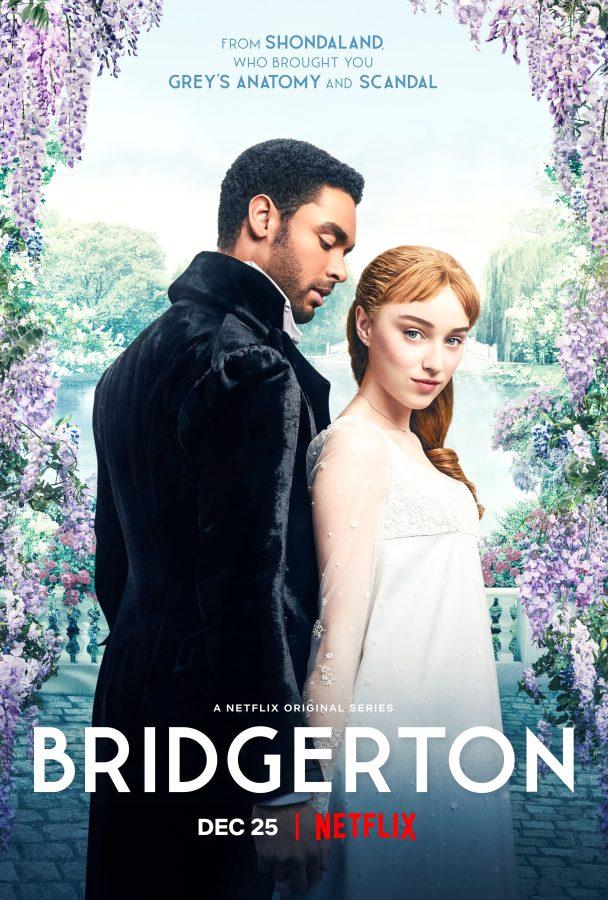“Bridgerton”: If you have an Internet connection, then you’ve heard of it. The show first graced the world on Christmas Day in 2020. Since then, it’s been called the “biggest series ever” on Netflix, being viewed by over eighty-two million accounts in its first month of streaming. The show is a classic costume and period drama, but it stands out from the genre with pleasing visuals, a semi-diverse cast, and a racy, risqué plot line. Daphne Bridgerton is the talk of the town when she amazes the queen at her annual court, presenting herself as suitable and ready for a grand proposal. Quickly, however, she faces challenges in the path to marriage, and must use her wit to strategize a way to maintain her family’s status and keep her head held high. “Bridgerton” focuses on the well-known idea that it was not easy to be a woman in the 1800s.
One of the most attractive aspects of “Bridgerton” is having your eyes delighted by the colorful fashions presented in the show. The “costumes” are an important aspect of any costume drama that wishes to provide a form of escapism; without convincing costumes, how will we be properly whisked away from our every-day lives? However nice to look at, “Bridgerton’s” costumes are not entirely accurate. UMass Boston sophomore KT Taylor offers us this knowledge: “The show is set in the year 1813, right in the middle of the Regency Era in England. Fashionable ladies’ dresses at the time were characterized by loose, narrow skirts and high waistlines. Most of the younger eligible women of the show dress in this way. One character who strays from these sensibilities is Queen Charlotte. Her wardrobe is notably different from the rest of the cast, and it is because she is 40 years outdated! The Queen wears robes a la francaise, which would have been in style in the mid-1700s. This design choice is hardly acceptable because as the Queen, her highness would be expected to, as well as have the funds to, dress in the most fashion forward way.” Though a historical inaccuracy in the Queen’s wardrobe is a large error, perhaps we may forgive it when we factor in what the show did right in terms of historical fashion. Taylor adds that “the court scene in the first episode… (was)… an accurate fashion moment in the show. Young women who were presenting for the first time in front of the Queen would be expected to wear white and have feathers in their hair.” In another historical accuracy, it is surprising to learn that the bright and diverse colors of the fashions in “Bridgerton” were more accurate than watchers may assume. Taylor says, “Faded ephemera, surviving garments, and old paintings are often misinterpreted as the reality of historical eras. When in actuality, upper class Regency families loved to sport rich, beautifully colored gowns because it was a symbol of wealth.” However, they add, “The more fluorescent, neon colors are not (as) realistic.”
“Bridgerton” has been markedly criticized for its lack of substance (spoiler alert ahead). The show’s producers seem to have put a lot of thought into the visual aspect and little thought into the plotline, which follows the overdone conventions of enemies-to-lovers and faked-love-turns-real, seen recently in the likes of “To All the Boys I’ve Loved Before.” Such conventions are so predictable that one can almost entirely guess the outcome of Daphne and the Duke’s situation.
Additionally, several critics have pointed out that the show attempts to appear inclusive of race but does not give much fictional justification as to why it is diverse. Such critics as Michael Blackmon ask the apt question: If the show is diverse just for the sake of being diverse, why are there far more white actors than black—and a total lack of any other race?
Despite the areas in which the show lacks, this period drama has plenty of positive attention. There is something to be said for a show that can distract people from the daily mundanities of life during the COVID-19 pandemic. Additionally, we must applaud the casting of Phoebe Dynevor, who brings Daphne Bridgerton to light like no other could. Her gentle demeanor paired with her sharp wit makes her a gem that comes up fighting against a society that forces her into an unappealing role and confines her with compulsory ignorance and required carefulness at every turn. Alone, she makes this show worth a try.
“Bridgerton”: what they did right and what they did wrong
February 5, 2021





















































